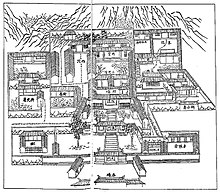This article needs additional citations for verification. (October 2008) |
| Yamen | |||||||||||||||
|---|---|---|---|---|---|---|---|---|---|---|---|---|---|---|---|
 The former yamen in Kowloon Walled City Park, Hong Kong. | |||||||||||||||
| Chinese name | |||||||||||||||
| Traditional Chinese | 衙門 / 牙門 / 官衙 | ||||||||||||||
| Simplified Chinese | 衙门 / 牙门 / 官衙 | ||||||||||||||
| |||||||||||||||
| Vietnamese name | |||||||||||||||
| Vietnamese alphabet | Quan nha / Nha môn | ||||||||||||||
| Chữ Hán | 官衙 / 衙門 / 牙門 | ||||||||||||||
| Korean name | |||||||||||||||
| Hangul | 관아 | ||||||||||||||
| Hanja | 官衙 | ||||||||||||||
| |||||||||||||||
| Manchu name | |||||||||||||||
| Manchu script | ᠶᠠᠮᡠᠨ | ||||||||||||||
| Möllendorff | yamun | ||||||||||||||


A yamen (ya-men; traditional Chinese: 衙門; simplified Chinese: 衙门; pinyin: yámén; Wade–Giles: ya2-men2; Manchu: ᠶᠠᠮᡠᠨyamun) was the administrative office or residence of a local bureaucrat or mandarin in imperial China, Korea,[1] and Vietnam.[2][3] A yamen can also be any governmental office or body headed by a mandarin, at any level of government: the offices of one of the Six Ministries is a yamen, but so is a prefectural magistracy. The term has been widely used in China for centuries, but appeared in English during the Qing dynasty[citation needed].
- ^ 안길정, 관아를 통해서 본 조선시대 생활사, 2000년, 사계절. (in Korean).
- ^ Đỗ Hoàng Anh (6 June 2023). "Thêm thông tin và hình ảnh lưu trữ về Trung tâm đô thị Tuyên Quang thời Pháp" (in Vietnamese). Trung tâm Lưu trữ quốc gia I (National Archives Nr. 1, Hanoi) - Cục Văn thư và Lưu trữ nhà nước (State Records And Archives Management Department Of Việt Nam). Retrieved 10 June 2023.
- ^ “Hán Việt tân từ điển” (Hán-Việt New Dictionary) - Nguyễn Quốc Hùng. Entry: 衙門 nha môn Quote: Từ điển trích dẫn 1. Sở quan. § Ta gọi là “quan nha” 官衙 hay là “nha môn” 衙門 . Ngày xưa trước quân trướng đều cắm lá cờ có tua như cái răng lớn, nên gọi là “nha môn” 衙門, nguyên viết là 牙門.